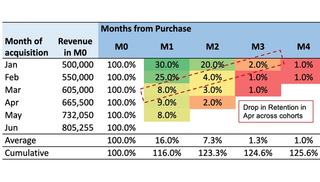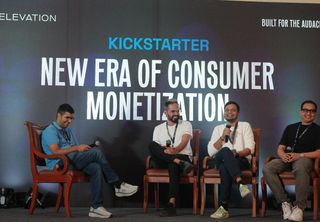Customer Loyalty in the age of Direct-to-Consumer
Understanding repeats for D2C brands
Customer Loyalty in the age of Direct-to-Consumer
Understanding repeats for D2C brands
Recap: The Skincare Company (TSC) is a new-age skincare brand that uses “watermelon” as the hero ingredient across their products, from face washes and moisturizers to serums and hair gels, sold on their own website and digital marketplaces. There has been a steady growth in their revenue. In the last few months, however, there has also been a significant increase in the marketing costs, leading to cash burn every month.
In Part 1, we discussed how TSC had identified high CAC and low repeats as the key issues behind unsustainable increase in marketing costs. While they were able to innovate on marketing to reduce the CAC, the repeats still remain low.
In Part 2, we will discuss how TSC measures and improves the repeat behaviour for their products.
Using cohorts to understand repeats
The TSC team has been tracking the repeats (% of total revenue) over the last few months—unfortunately, it has been largely flat. They use this metric because it is available readily on Shopify. Repeat (% of revenue) is dependent both on repeat behaviour and how fast the top line is growing. For example, if TSC grows 2x in revenue and repeats grow at the same pace, then repeats (% of revenue) will look flat.
As we can see, this trend is not quite helpful in isolation to understand the root cause of low repeats. Instead, cohorts are more effective to study repeats as they can provide actionable insights on product and marketing approaches.

The TSC team needs to review cohorts of customers and see how their engagement with the brand is tracking over time. Cohorts are generally created on a monthly basis, but can be created based on expected product-usage frequency. Since most of TSC's products last for 20-45 days, monthly cohorts are better suited for this study. For 2-3 months frequency purchases, quarterly cohorts work better.
Reading and analyzing cohorts

In this table, we can see that customers acquired in January fetched a revenue of INR 5 lakh in the first month. The M1 retention of 30% for Jan cohort indicates that these customers spent ~INR 1.5 lakh (30% of INR 5 lakh) in Feb and so on.
Average Retention provides a summary view of the repeat behaviour of consumers across cohorts. Cumulative retention essentially indicates the total revenue generated from an average customer throughout their lifecycle.
Similarly, cohorts can also be created for customers (to capture % of customers who repeat) and Average order Value (to see basket expansion/contraction over time for a customer).
(We have also created a sheet template to create and play around with cohorts)

A great cohort is defined by the following characteristics:
- M1 retention increases over time, indicating improvement in product efficacy, better shopping experience on the website, more categories, better remarketing, etc.
- Plateauing after a few months showing that some users have stuck with the brand in the long-term.
Understanding the insights derived from cohorts
Based on their cohorts, TSC realized that something had gone drastically wrong in April given the significant decline across all customer cohorts. The team's hypothesis is that their new vendor, onboarded in March, was not manufacturing good-quality products. After speaking to several loyal customers (who had churned in April), they realized that the new vendor's products were significantly worse in efficacy.
The team then decided to review product-based cohorts with a filter for the first product purchased—e.g., the watermelon face wash cohort would only include customers whose first purchase with the brand was that product—that led to some interesting insights.
- Face wash: They could clearly see better repeats from users who started with face wash compared to other products. These customers often ended up buying several other products along the way. This was a clear indication to TSC that they should continue to focus on acquiring most of their customers on the face wash.
- Moisturizer: The team learnt that their moisturizers had only average repeats, but the customers who repeated were mostly men (surprisingly) despite women being the brand’s core TG. Men liked the product as it was more effective on their tougher skin, while women disliked it for the same reason. TSC realized that they would have to (1) launch a softer version of the moisturizer for their target audience and (2) start to market the current product specifically to men.

TSC implemented these changes quickly and saw their retention improve over the next year. M12 cumulative retention reached ~170% and cohorts plateaued at 8%, equivalent to 3-years cumulative retention of ~300%. The LTV/CAC improved, as a result, to ~3.2

The High LTV/CAC, i.e., stronger repeats and lower CAC create a virtuous cycle of (1) existing customers bringing in a larger repeat revenue every month and (2) new customers being acquired at an efficient cost. As a result, TSC could see its marketing spend come back in control while continuing to grow at a fast pace.
Learnings on understanding repeat behaviour
- Cohorts are a great way to understand the repeat behaviour of customers. Strong repeat behaviour is shown by cohorts plateauing after some time.
- Cohorts should improve over time as the brand and its value proposition grow stronger
- Cohorts can be used to diagnose real-world issues such as product quality, effects of delivery timelines, A/B testing between similar products, etc.
- However, cohorts are a lagging indicator. Brands should also measure leading indicators such as NPS or CSAT to gain insights on these issues faster.
- Most importantly, there is no substitute for talking to customers. It is incredibly important to combine these analyses with customer experiences to really understand the root cause and get to actionable insights.
Written by Chirag Chadha, Deepak Gaur, Mukul Arora
Related

Vridhi: Reimagining Home Lending For Bharat's Self-Employed
Ram Naresh Sunku, Co-founder, Vridhi Home Finance
11.12.2024

Investing in Plena Data
Automating manual accounting tasks and improving employee experience with robots
14.10.2021

Monetization Strategies That Work: Insights from Consumer Tech Founders
Insights on what works when it comes to monetizing consumer apps in India.
10.12.2024